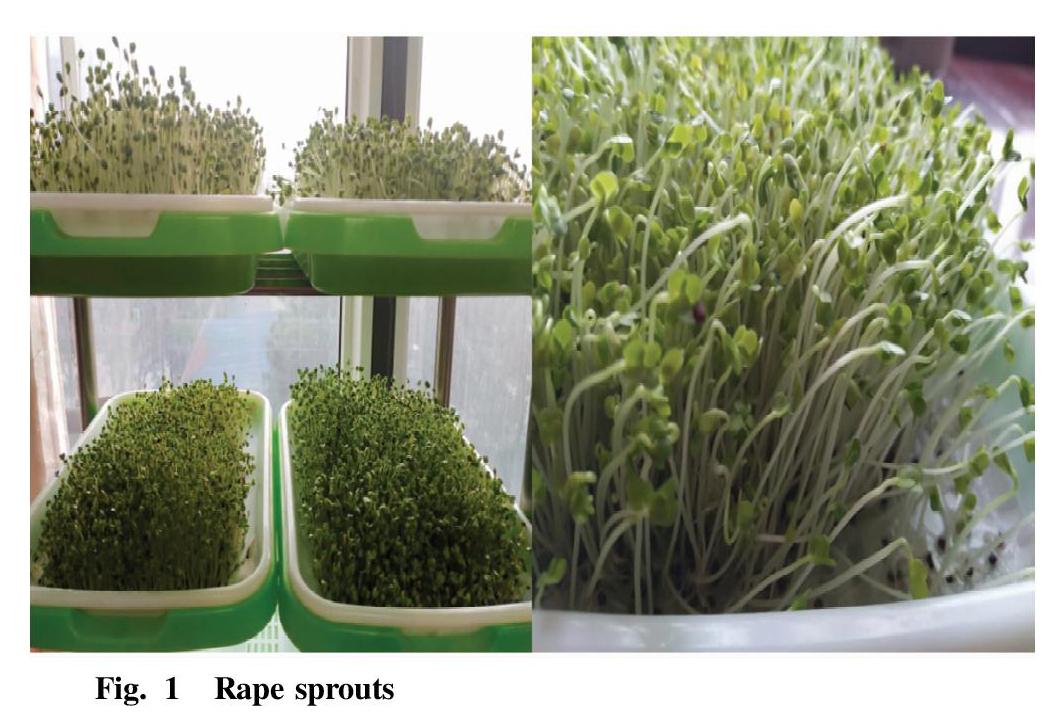Home Planting Techniques of Green and Healthy Rape Sprouts
Nian LIU Tianze TANG Yan ZHU Qixin FAN Daqing MENG Yingchun LI Zhifan LI Jun CHEN

Abstract With the continuous development of society and the continuous improvement of people餾 income levels, consumers demand for agricultural products has also changed. Rape sprouts as a new type of green and pollution-free health food meet people餾 needs. In this paper, we summarized a set of home cultivation techniques for green and healthy rape sprouts. The techniques are simple to operate and low in cost. Growers can notonly experience the fun of planting and but also taste green and healthy food.
Key words Rape sprouts; Home planting; Technology
Received: June 7, 2021 Accepted: August 15, 2021
Supported by National Rape Industry System Construction Project (CARS-12); Sichuan Innovation Team Project (2019-2023).
Nian LIU (1985-), female, P. R. China, senior agronomist, master, devoted to research about rape quality analysis and cultivation.
*Corresponding author.
With the continuous development of society and the continuous improvement of people餾 income levels, consumers demand for agricultural products has also changed. Safety, green, and health are the basic needs of consumers in modern society[1]. Rape is one of the main oil crops in China, and is the fifth dominant crop after rice, wheat, corn, and soybeans. It is also the largest oil crop in Sichuan and an irreplaceable winter crop[2-3]. In recent years, in order to meet the needs of modern consumers and expand the rape industry, the multi-functional use of rape has been continuously explored, mainly for oil, industrial, vegetable, fertilizer, feed, honey, medicinal and ornamental functions[4-7]. The nutritional value and functions of rape bolts are gradually accepted by people and become a delicacy on people餾 tables[8]. Rape sprouts, as a new type of green and healthy vegetable, have become the new favorite on the table. Rape sprouts is edible parts such as young stems of rape grown in clean drinking water by shading and facing the light. They are eaten freshly after being picked. The whole growth process requires no pesticides or chemical fertilizers, and it is thus safe, green, and pollution-free and has low cost but high yield. The operation is simple and easy to learn, and they can be cultivated at home or produced in a factory[9-10]. Rape sprouts are fresh and crispy, rich in vitamins, trace elements, plant protein, etc. The vitamin C content is about 5-7 times that of celery and cabbage, the calcium content is equivalent to twice that of cabbage and cabbage, and the iron content is roughly 2-5 times that of celery and cabbage. Eating more rape sprouts can achieve the effects of fighting fatigue, delaying aging, treating obesity, and beautifying skin. Rape sprouts can be eaten in many ways, such as stir-frying, cold and dressing with sauce, hot pot, side dish for soups, fillings, etc., and are of great significance in enriching consumers food culture.
Seed selection
Double-low full fresh rapeseeds (low glucosinolates and ercic acid) with high germination rate and less impurities are selected. The selection of seeds has a great influence on the quality of sprouts. Full rapeseeds make it easier to obtain strong, commercial sprouts. Germination rate is an important factor affecting the yield of rape sprouts, and rapeseeds with high germination rate produces higher yield of sprouts.
Sowing
Firstly, rapeseeds are screened to remove impurities, shrunken grains, soil, etc., and then the screened rapeseeds are washed with clean water to remove dust on the surface.
Preparation before sowing
The sowing of rapeseeds requires seedling trays, clean white paper and watering can. The size of the seedling trays is determined according to needs. The seedling trays are divided into upper and lower layers, of which the upper layer has a plurality of neatly arranged sieve holes, and the lower layer has a water storage tray. In this way, the roots of rape sprouts can better pierce the grid tray and contact the moisture of the bottom tray, absorb nutrients, and make the sprouts thicker. The seedling trays can be used repeatedly, but before use, the seedling trays must be washed repeatedly and sterilized by exposing it to the sun for 1 h. Clean white paper (such as printing paper) that is clean and non-toxic and harmful, is selected. Before use, the white paper is cut or folded into the same size as the bottom of the seedling trays, and is just laid right inside the tray.
Sowing
The seedling trays are placed flat on the ground or balconies, and the cut paper is laid in the trays, watered thoroughly with a watering can, and arranged to ensure that the white paper is flat. Then, the selected rapeseeds are spread evenly on white paper. Because the surface of the rapeseeds is smooth and easy to roll together, it is necessary to try not to stack the rapeseeds when sowing. The rapeseeds are slowly sprayed with a can to wet them.
Pre-germination
The pre-germination can be done by stacking trays or covering with paper[9]. The tray stacking method requires different treatments according to temperatures and seasons. For example, in winter, one tray can be tightly fastened to another tray to overlap, generally 5-10 layers, which is best. In summer, we can choose to stack in the shape of a box, stacking 1-2 trays horizontally, 1-2 trays vertically, and the height can also be 5-10 layers. The paper covering method is to cover the sown rapeseeds with cut white paper, water the paper and rapeseeds thoroughly with a watering can, and place them flat on the ground or on balconies. Regardless of whether the seeds are in the stacked stage or the paper cover stage, they are watered 3-4 times a day in winter and 5-6 times in summer. Attention is paid to water consumption when watering, because too much water can easily rot the seedlings, or cause the sprouts to grow slowly and grow irregularly. The plate stacking method requires watering in separate trays and then stacking the trays, and direct watering can be adopted for the paper covering method. Rapeseed sprouts can grow for 5-6 d in winter and 3-4 d in summer at room temperature. After the sprouts are about 1-2 cm high, they can uncovered by trays.
Seedling management
Rape sprouts like light, and as the sprouts grow, the demand for light intensity is also increasing. After division from trays to more trays, rape sprouts should be placed in a light-facing place to promote growth. In the whole process of sprout cultivation, watering should be done in time, usually 3 to 4 times a day. If planting is carried out in winter and spring, the sprouts will only need to be sprayed 2 to 3 times a day. The sprouts should be sprayed for more times but not too much at one time. The humidity in the air should be kept at about 85%. Frequent ventilation should be carried out. When encountering relatively cold weather, short-term ventilation should also be carried out[9].
Harvesting
The growth of rape sprouts is relatively vigorous (Fig. 1). Generally, they can be harvested 5-7 d after emergence, and the sprouts taste the best during this period. The rape sprouts can be cut off with scissors for eating.
References
[1] WANG HZ. New-demand oriented oilseed rape industry developing strategy[J]. Chinese Journal of Oil Crop Sciences, 2018, 40(5): 613-617. (in Chinese)
[2] LIU N, TANG TZ, FAN QX, et al. Effects of different sowing and picking methods of vegetable rape ‘Guohao Oil No.5 on yield and economic benefit[J]. Tianjin Agricultural Sciences, 2019, 25(7): 78-82. (in Chinese)
[3] LIU N, TANG TZ, ZHONG SC, et al. Effects of different sowing patterns on growth, development and yield of rape in Sichuan hilly areas[J]. Tianjin Agricultural Sciences, 2018, 24(7): 67-70. (in Chinese)
[4] ZHANG Z, YIN Y, LIU F, et al. Current situation and development countermeasures of Chinese rapeseed multifunctional development and utilization[J]. Chinese Journal of Oil Crop Sciences, 2018, 40(5): 618-623. (in Chinese)
[5] LIU ZQ, WANG HJ, et al. A review of research on multifunctional development and utilization of rape[J]. XianDai NongYe KeJi, 2009, 24: 1-6. (in Chinese)
[6] WANG XR, LI QY, GUAN X. Research progress of rape used as a green manure and vegetable[J]. Crop Research, 2015, 29(5): 555-557. (in Chinese)
[7] LIU N, TANG TZ, FAN QX, et al. Effects of different fertilizing quantity on yield and economic benefit of rape varieties [J]. Hubei Agricultural Sciences, 2020, 59(18): 71-72. (in Chinese)
[8] MA CZ, DAI C, LIU MX, et al. Home cooking practice of Brassica napus bolts[J]. Journal of Changjiang Vegetables, 2019(10): 30-32. (in Chinese)
[9] LIU JJ, JIANG NN, XIAO ML, et al. Method of growing rape sprouts[J]. Journal of Changjiang Vegetables, 2020(10): 34-36. (in Chinese)
[10] CHEN H, LIANG XJ, ZHANG Y, et al. Green food: Home production technology of sprouts[J]. Journal of Changjiang Vegetables, 2018(7): 37-38. (in Chinese)
- 农业生物技术(英文版)的其它文章
- Effects of Pruning Methods on the Growth and Development of New Shoots and Fruit Yield and Quality of Walnut
- Selection of Grape Varieties Suitable for Double Cropping a Year in Northern Greenhouse
- Effects of Uniconazole on Photosynthetic Characteristics of Dahlia pinnata Cav. under Drought Stress
- Community Structure and Value Evaluation of Local Brassicaceae Potherbs in Shiyan City
- Research Progress of Polygonatum Germplasm Resources in China
- Breeding and Application of Guidan 903, a New High-yield and Good-quality Maize Variety

